不定式作状语
- 格式:ppt
- 大小:58.00 KB
- 文档页数:4
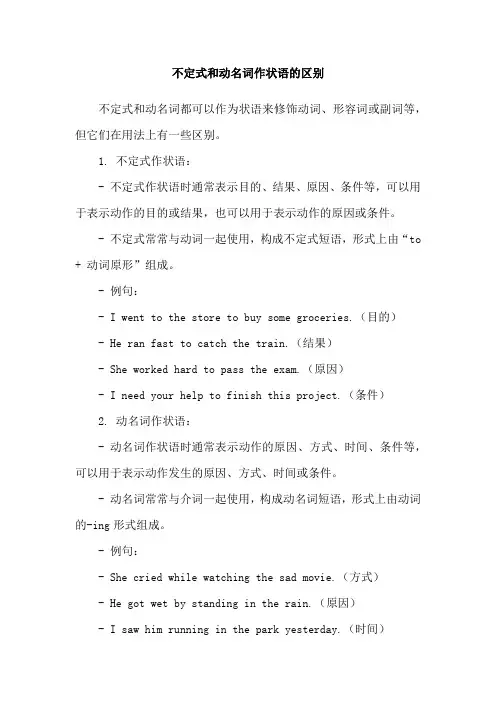
不定式和动名词作状语的区别
不定式和动名词都可以作为状语来修饰动词、形容词或副词等,但它们在用法上有一些区别。
1. 不定式作状语:
- 不定式作状语时通常表示目的、结果、原因、条件等,可以用于表示动作的目的或结果,也可以用于表示动作的原因或条件。
- 不定式常常与动词一起使用,构成不定式短语,形式上由“to + 动词原形”组成。
- 例句:
- I went to the store to buy some groceries.(目的)
- He ran fast to catch the train.(结果)
- She worked hard to pass the exam.(原因)
- I need your help to finish this project.(条件)
2. 动名词作状语:
- 动名词作状语时通常表示动作的原因、方式、时间、条件等,可以用于表示动作发生的原因、方式、时间或条件。
- 动名词常常与介词一起使用,构成动名词短语,形式上由动词的-ing形式组成。
- 例句:
- She cried while watching the sad movie.(方式)
- He got wet by standing in the rain.(原因)
- I saw him running in the park yesterday.(时间)
- They felt happy after finishing the project.(条件)总的来说,不定式更侧重于表示动作的目的、结果、原因或条件,而动名词更侧重于表示动作的原因、方式、时间或条件。
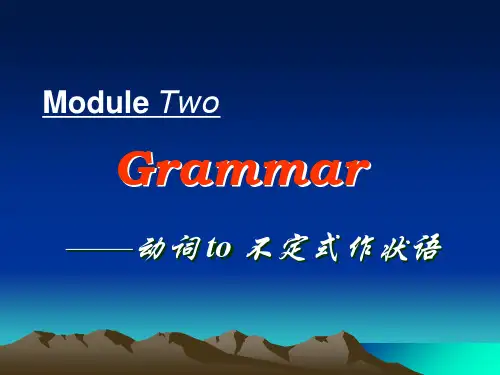

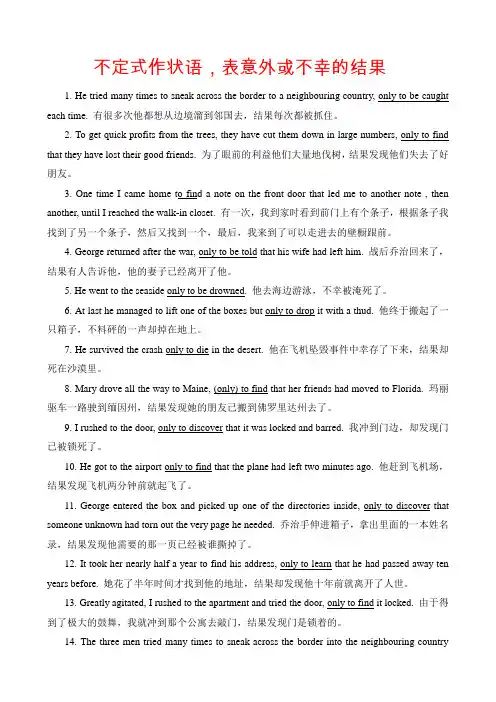
不定式作状语,表意外或不幸的结果1. He tried many times to sneak across the border to a neighbouring country, only to be caught each time. 有很多次他都想从边境溜到邻国去,结果每次都被抓住。
2. To get quick profits from the trees, they have cut them down in large numbers, only to find that they have lost their good friends. 为了眼前的利益他们大量地伐树,结果发现他们失去了好朋友。
3. One time I came home to find a note on the front door that led me to another note , then another, until I reached the walk-in closet. 有一次,我到家时看到前门上有个条子,根据条子我找到了另一个条子,然后又找到一个,最后,我来到了可以走进去的壁橱跟前。
4. George returned after the war, only to be told that his wife had left him. 战后乔治回来了,结果有人告诉他,他的妻子已经离开了他。
5. He went to the seaside only to be drowned. 他去海边游泳,不幸被淹死了。
6. At last he managed to lift one of the boxes but only to drop it with a thud. 他终于搬起了一只箱子,不料砰的一声却掉在地上。
7. He survived the crash only to die in the desert. 他在飞机坠毁事件中幸存了下来,结果却死在沙漠里。

不定式作状语的例句1. 不定式作目的状语,哎呀,就像你为了吃那块美味的蛋糕,专门跑去蛋糕店一样,“He came here to see me.”他来这儿就是为了看我呀!2. 不定式作结果状语,哇塞,就好比你努力复习后终于考了个好成绩,“He woke up late only to find the bus had left.”他起晚了,结果却发现公交车已经开走啦!3. 不定式作原因状语,嘿,这就像你因为喜欢她所以总是想见到她呀,“She was happy to hear the good news.”她听到这个好消息很高兴呢!4. 不定式作条件状语,可不就像如果你努力锻炼就能变得强壮一样嘛,“To succeed, you must work hard.”要成功,你就得努力工作呀!5. 不定式作让步状语,哎呀呀,就像尽管困难重重,你还是坚持下去一样,“He went to work不定式作让步状语,哎呀呀,就像尽管困难重重,你还是坚持下去一样,“He went to work despite being tired.”尽管很累,他还是去上班了呢!6. 不定式作程度状语,哇哦,就好像他极其努力地工作,“He worked so hard to achieve his goal.”他为了实现目标那么努力地工作呀!7. 不定式作目的状语,这就如同你为了减肥而每天跑步,“I studyhard to get good grades.”我努力学习就是为了取得好成绩嘛!8. 不定式作结果状语,好比你跑太快不小心摔倒了,“He ran fast only to tri p over.”他跑得太快结果绊倒了呀!9. 不定式作原因状语,不就像你因为兴奋所以睡不着觉嘛,“He was excited to stay up late.”他因为兴奋所以熬夜了呀!10. 不定式作目的状语,就像你为了看日出而早起,“She got up early to watch the sunrise.”她早起就是为了看日出呢!我觉得啊,不定式作状语真的很有趣很实用呢,能让我们的表达更加丰富多样呀!。
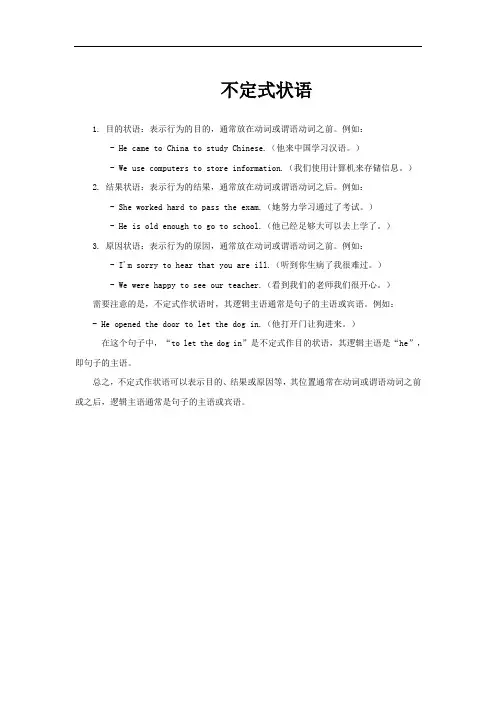
不定式状语
1. 目的状语:表示行为的目的,通常放在动词或谓语动词之前。
例如:
- He came to China to study Chinese.(他来中国学习汉语。
)
- We use computers to store information.(我们使用计算机来存储信息。
)
2. 结果状语:表示行为的结果,通常放在动词或谓语动词之后。
例如:
- She worked hard to pass the exam.(她努力学习通过了考试。
)
- He is old enough to go to school.(他已经足够大可以去上学了。
)
3. 原因状语:表示行为的原因,通常放在动词或谓语动词之前。
例如:
- I'm sorry to hear that you are ill.(听到你生病了我很难过。
)
- We were happy to see our teacher.(看到我们的老师我们很开心。
)
需要注意的是,不定式作状语时,其逻辑主语通常是句子的主语或宾语。
例如:
- He opened the door to let the dog in.(他打开门让狗进来。
)
在这个句子中,“to let the dog in”是不定式作目的状语,其逻辑主语是“he”,即句子的主语。
总之,不定式作状语可以表示目的、结果或原因等,其位置通常在动词或谓语动词之前或之后,逻辑主语通常是句子的主语或宾语。

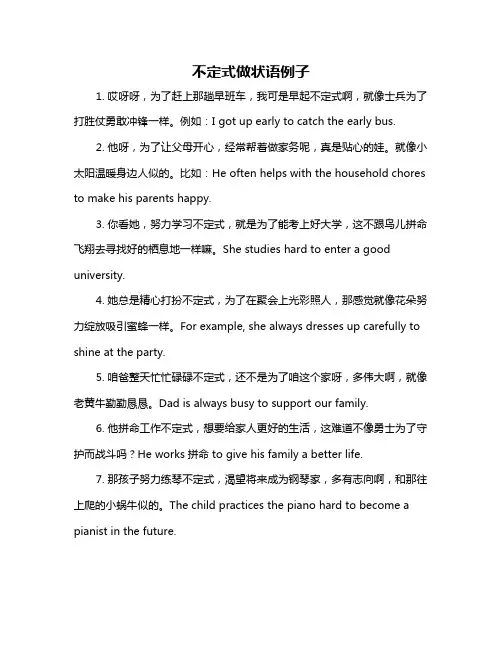
不定式做状语例子1. 哎呀呀,为了赶上那趟早班车,我可是早起不定式啊,就像士兵为了打胜仗勇敢冲锋一样。
例如:I got up early to catch the early bus.2. 他呀,为了让父母开心,经常帮着做家务呢,真是贴心的娃。
就像小太阳温暖身边人似的。
比如:He often helps with the household chores to make his parents happy.3. 你看她,努力学习不定式,就是为了能考上好大学,这不跟鸟儿拼命飞翔去寻找好的栖息地一样嘛。
She studies hard to enter a good university.4. 她总是精心打扮不定式,为了在聚会上光彩照人,那感觉就像花朵努力绽放吸引蜜蜂一样。
For example, she always dresses up carefully to shine at the party.5. 咱爸整天忙忙碌碌不定式,还不是为了咱这个家呀,多伟大啊,就像老黄牛勤勤恳恳。
Dad is always busy to support our family.6. 他拼命工作不定式,想要给家人更好的生活,这难道不像勇士为了守护而战斗吗?He works拼命 to give his family a better life.7. 那孩子努力练琴不定式,渴望将来成为钢琴家,多有志向啊,和那往上爬的小蜗牛似的。
The child practices the piano hard to become a pianist in the future.8. 她节食不定式,为了能穿上那条漂亮裙子,这执着劲真让人佩服,跟那追求梦想的人一样。
She is on a diet to fit into that beautiful dress.9. 他们夜以继日地训练不定式,就是为了在比赛中获得好成绩,这和运动员准备奥运会有啥区别呀。
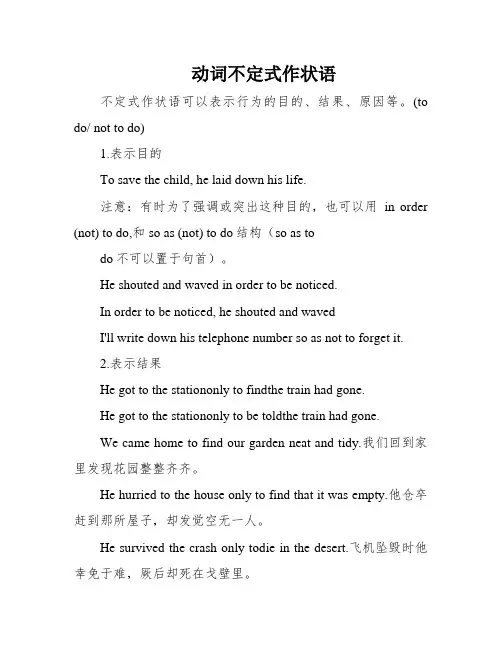
动词不定式作状语不定式作状语可以表示行为的目的、结果、原因等。
(to do/ not to do)1.表示目的To save the child, he laid down his life.注意:有时为了强调或突出这种目的,也可以用in order (not) to do,和so as (not) to do结构(so as todo不可以置于句首)。
He shouted and waved in order to be noticed.In order to be noticed, he shouted and wavedI'll write down his telephone number so as not to forget it.2.表示结果He got to the stationonly to findthe train had gone.He got to the stationonly to be toldthe train had gone.We came home to find our garden neat and tidy.我们回到家里发现花园整整齐齐。
He hurried to the house only to find that it was empty.他仓卒赶到那所屋子,却发觉空无一人。
He survived the crash only todie in the desert.飞机坠毁时他幸免于难,厥后却死在戈壁里。
After the meeting, they parted,never tosee each other again.He went abroad, never to be heard from.不定式透露表现成效常见于以下句型。
1)so ... as to doWould you be so kind as to lend me your bicycleI’m not so simpleas to think it will be easy.我决不至于笨得以为那是容易的事。

动词不定式做目的状语动词不定式作为状语在英语中使用广泛,其中以不定式做目的状语的句型尤为常见。
本文将分别介绍该句型的用法和常见的翻译方法。
一、动词不定式做目的状语的用法动词不定式做目的状语通常放在句尾,用于表示一个动作或行为发生的目的或目标,常用的结构是"to+动词原形",如:- He went to the supermarket to buy some groceries. 他去超市买了一些杂货。
- She studies hard to get good grades. 她努力学习以获得好成绩。
- They took a cab to get to the train station on time. 他们乘出租车以便准时到达火车站。
二、动词不定式做目的状语的翻译方法在翻译中,我们需要注意句子的主语、动词、宾语和to不定式一起构成句子的表达方式。
常用的翻译方法有以下三种:1. 直接翻译直接翻译是最常用、最基础的翻译方法。
具体操作是将原文中的to不定式直接翻译成为汉语中的"为了"或"以便"等连接词。
例如:- He went to the supermarket to buy some groceries. 他去超市买了一些杂货。
- 翻译为:他去超市是为了买一些杂货。
2. 忽略to不定式在某些情况下,汉语中省略某些无实义的连接词是比较自然的表达方式,这种方法也适用于不定式做目的状语的翻译。
例如:- She studies hard to get good grades. 她努力学习以获得好成绩。
- 翻译为:她努力学习获得好成绩。
3. 翻译为“为了”翻译为"为了"是一种泛化的表达方法,它将原文中的to不定式整体翻译成"为了",以简化了句子的表达,这种方法尤其适用于一些长句。
例如:- They took a cab to get to the train station on time. 他们乘出租车以便准时到达火车站。

不定式作状语例子
1. 哎呀呀,不定式作状语表示目的的时候可多啦!比如说,我每天早起去跑步,“to run”就是表示我早起的目的呀,这不就是为了保持健康嘛!
2. 嘿,不定式作状语还能表结果呢!你看那个小偷拼命跑,结果还是被警察抓住了,这里的“to be caught”不就是一个结果嘛!就像那只小老鼠怎么逃也逃不掉被猫抓住的命运哟!
3. 哇塞,不定式作状语表示原因也挺有意思的呀!他高兴得跳起来去拥抱朋友,“to hug his friend”不就是因为高兴嘛,这就好像你中了大奖肯定会兴奋得做点啥一样!
4. 哟呵,不定式作状语还能在一些固定搭配里出现呢!比如 be able to do,她努力学习就是为了能够考上好大学呀,这里的“to enter a good university”多重要啊!
5. 嘿呀,不定式作状语在有些情况下也能表示条件呢!要是努力工作,就有可能得到晋升,“to get a promotion”不就是在那个条件下的可能嘛,就像你种瓜得瓜种豆得豆呀!
6. 哈哈,不定式作状语的用处可真多呀!像他去商店买礼物,“to buy a gift”不就是他去商店的一个理由嘛,这多明显呀!
结论:总之,不定式作状语在英语中真是太常见且好用啦,大家要好好掌握哟!。
不定式短语作状语要理解不定式作状语我们必须要明白以下几点。
①可以做什么状语②不定式的动作行为与主句主语的关系③不定式短语如何转化为一个相应的状语从句。
一般来说不定式在句中通常做目的,原因和结果状语。
下面分别举例说明:1,不定式做目的状语可以放在句首,也可以放在句末。
放在句首时,需要加逗号与句子隔开,放在句末时不需要隔开。
如To ca tch t he fi rst b us, L i Lei star ted o ut ea rly.Momopene d the wind ow to letsomefresh airin. 注意为了强调目的状语,可以用i n ord er to do 或者 soas to do。
In or der t o do前后均可,而 soas to do只能放在后面。
如Mo m ope ned t he wi ndowso as to l et so me fr esh a ir in.2,不定式做原因状语往往要放在表示人的喜怒哀乐等情感的形容词或分词之后。
这些形容词有angry,anxi ous,c onten t,cle ver,c ruel,delig hted,disap point ed,ex cited,fool ish,g lad,h appy,pleased,po und,r eady,sorry,surp rised,will ing,f ortun ate,r ight,wrong,fool ish,l uck,q uick,slow等。
注意不要用逗号隔开。
如I am g lad t o see you.Man y peo ple a re co ntent to l ive a simp le li fe.3,不定式作结果状语,注意下面几种情况:①Onl y todo表示出人意料、意想不到的结果eg. wehurri ed to therailw ay st ation only to f ind t he tr ain h ad le ft.②enoug h todo, t oo…to do结构eg. The boyisn’t oldenoug h togo to scho ol. = Theboy i s too youn g togo to scho ol.③在so(s uch)…as to do结构中,意为‘如此……以致……’eg. I am n ot su ch afoolas to beli eve a chea t. He is s o kin d asto he lp th e old lady offthe b us.一般说来不定式作状语的逻辑主语必须是主句主语,主句主语和不定式的动词存在着动作上的主谓和动宾关系。
不定式作状语
1)目的状语
to… only to (仅仅为了), in order to, so as to, so(such)… as to… (如此……以便……)
he ran so fast as to catch the first bus. 他飞快地跑以便赶上第一班车。
i come here only to say good-bye to you. 我来仅仅是向你告别。
2)作结果状语,表事先没有预料到的,要放在句子后面。
what have i said to make you angry.
he searched the room only to find nothing.
3) 表原因
i'm glad to see you.
典型例题
the chair looks rather hard, but in fact it is very comfortable to ___.
a. sit
b. sit on
c. be seat
d. be sat on
答案:b. 如果不定式为不及物动词,其后应有必要的介词。
当动词与介词连用时,常位于"形容词+动词不定式"结构的末尾。
怎么区分不定式做目的定语或状语在英语语法中,不定式可以作为定语或状语。
定语不定式修饰名词或代词,而状语不定式修饰动词、形容词、副词或整个句子。
当初学英语的时候,很容易搞混两者的用法,因为它们的构造形式很相似,都是由“to + 动词原形”组成。
但是,它们的作用却有很大的区别。
以下是一些区分不定式作为目的定语或状语的方法:1. 位置:不定式作为状语通常位于谓语动词之后,而不定式作为定语则位于被修饰的名词或代词之后。
例如:- I need a book to read tonight.(这里的不定式作为定语,修饰名词“book”,说明是什么样的书)- I went to the library to read a book.(这里的不定式作为状语,说明动作“去图书馆”是为了做什么,修饰整个句子)2. 意义:不定式作为定语时,它要么表示被修饰的名词或代词的用途、目的或特征,要么表示后面的名词或代词所需要的条件。
不定式作为状语,它通常表示一个目的、结果、原因等等。
例如:- She needs a pen to write with.(这里的不定式作为定语,说明她需要什么样的笔)- She went to the store to buy a pen.(这里的不定式作为状语,说明她去商店的目的是为了买笔)3. 可否省略:作为定语的不定式通常不能省略,因为它们对于句子的含义非常关键。
而作为状语的不定式可以省略,因为它们只是对句子陈述的补充。
例如:- I have some work to do.(这里的不定式作为定语,不能省略,表示“我要做的工作”)- He came to my house to talk.(这里的不定式作为状语,可以省略,修饰动作“来我家”)4. 上下文:上下文对于理解不定式的作用是至关重要的。
有时候,一个不定式既可以作为定语又可以作为状语,它的作用取决于上下文的意义。
例如:- He has a lot of books to read.(这里的不定式作为定语)- He has a lot of work to do, so he can't come tonight.(这里的不定式作为状语)总的来说,区分不定式作为目的定语或状语需要注意它们在句子中的位置、意义、可否省略以及上下文的含义。
不定式短语作状语
不定式短语作状语的情况有多种,主要取决于句子的语境和需要表达的意思。
以下是一些常见的不定式短语作状语的情况:
1.目的状语:不定式短语可以表示目的,放在句首或句末,表示主语执行某个动
作的目的。
例如:“To save money, he decided to cook at home instead of eating out.”
2.结果状语:不定式短语可以表示结果,放在句末,表示主语执行某个动作后得
到的结果。
例如:“He studied hard, and to his surprise, he passed the exam.”
3.条件状语:不定式短语可以表示条件,放在句首或句末,表示主语执行某个动
作的条件。
例如:“To succeed in business, you need to be persistent and determined.”
4.让步状语:不定式短语可以表示让步,放在句首或句末,表示主语在某种情况
下仍然坚持执行某个动作。
例如:“To be honest, I don’t like the idea of working overtime.”
总之,不定式短语作状语时,要根据句子语境和需要表达的意思选择合适的用法。
区分不定式作定语和状语不定式是英语中的一种非谓语动词形式,由"to + 动词原形"构成。
在句子中,不定式可以作为定语或状语,起到修饰名词或动词的作用。
本文将从不定式作为定语和状语两个方面进行区分讨论。
一、不定式作为定语不定式作为定语通常修饰名词或代词,用于说明名词或代词的用途、目的或性质等。
不定式作为定语时,常位于被修饰名词的前面或后面。
1. 位于名词前面的不定式作定语在这种情况下,不定式一般用来说明名词的用途、目的或性质。
例如:- I have a book to read.(我有一本书可读。
)- She needs a pen to write.(她需要一支笔来写作。
)- He has a car to drive.(他有一辆车可以开。
)在这些例子中,不定式to read、to write和to drive修饰名词book、pen和car,说明它们的用途或目的。
2. 位于名词后面的不定式作定语在这种情况下,不定式用于说明名词的性质或特征,常表示名词的所属关系。
例如:- The book to read is on the shelf.(可读的那本书在书架上。
)- The person to talk to is the manager.(要找的那个人是经理。
)- The place to visit is Paris.(值得去的地方是巴黎。
)这些例子中,不定式to read、to talk和to visit修饰名词book、person和place,表示它们的性质或特征。
二、不定式作为状语不定式作为状语通常修饰动词,用于说明动作的目的、结果或方式等。
不定式作为状语时,常位于句子的谓语动词后面。
1. 不定式作目的状语不定式作目的状语时,说明动作的目的或意图。
例如:- He went to the supermarket to buy some groceries.(他去超市买了些杂货。